Greetings, readers of the Fandomentals. Today I bring you a review of the new Avatar: The Last Airbender comic, Imbalance. I wrote about it before, being rather skeptical of how it would do. Having read it… my skepticism remains, but so far my impressions are mostly positive. Faith Erin Hicks, a new writer for the franchise, seems to know where she’s taking it. Let’s begin.
The story
We open with the Gaang traveling on Appa. Their destination is Yu Dao, but Toph asks Aang to stop by Earthern Fire Industries, which her father operates. I believe those first appeared in the Rift comic, but I haven’t read it. However, as it turns out, there’s far more than just a factory there. A whole town sprung up – Cranefish town. Which seems to be a predecessor of Republic City.
As befits a city that appeared so quickly, the whole place is distinctly ramshackle. The heroes land and meet with a rather cold welcome. The citizenry are entirely unconcerned with them and unimpressed by Aang’s bending. Soon enough, Toph’s father appears to welcome them… or rather, Aang, giving his daughter something of a cold shoulder. He says he needs the Avatar’s help.
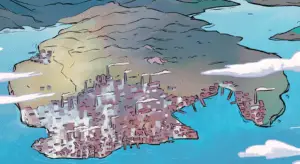
The reason for his asking becomes apparent shortly, as a fight breaks out between a firebender and earthbender gang. Aang tries to negotiate, only for both sides to claim they’re clearly in the right and he should support them. Toph, of course, swoops in to knock some sense into the fighters while Sokka uncharacteristically claims sometimes it’s best to stand aside and let benders blow off steam. This viewpoint seems shared by the leader of the earthbender gang, who tells all non-benders present to stay out of the way.
During the struggle, a nearby building starts collapsing. Toph tries to stop it, but Aang airbends her away instead, explaining that there was no saving it. Katara had evacuated the inhabitants, as it turns out (entirely off-screen, but more on that later), but the gang members had escaped.
Aang is surprised by how many people lived in that building and offers to rebuild it… only for the citizens to refuse because they don’t want benders’ help. Aang and Sokka head to the city’s “business council”, while Toph and Katara go to the factory. Toph is rather cross with her father for snubbing her.
The council meeting is eventful and reveals the bender/non-bender tensions that split the city. The two groups sit on the opposite sides of the chamber and it quickly becomes obvious why. Non-benders don’t feel safe walking their own streets and Lao proposes a radical solution: ban bending in the streets. This goes about as well as you would expect.
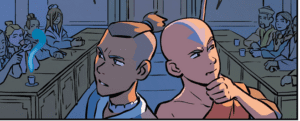
Meanwhile, Toph and Katara visit the factory, which turns out to have grown in size, scope, and technology. Satoru also reveals another side to the conflict plaguing the city: benders losing their jobs. After introducing more advanced ore-processing machinery, the help of benders wasn’t as needed, so he let some of them go to reduce costs, as skilled benders get paid more. This made the other feel they were being replaced, so they quit in protest. This included the factory’s earthbender guards, which is why non-benders protect it now. Things got worse when other factories adopted the same technology, leading to more benders losing work.
In the council chamber, Aang opposes the bending ban, as it would punish honest benders as well. He suggests instead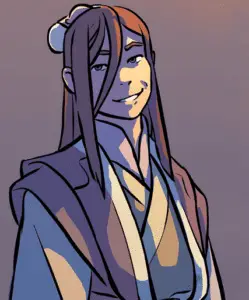 to create a proper police force that would keep Cranefish Town safe. One of the bending councilors, Liling, quickly rises to support him. She says she has a “skilled security team” that can become the town’s police force with some training. Lao points out that the police force should also include non-benders, which is quickly brushed off as something that will be taken care of after the benders are trained. He still has doubts, but the council promptly votes in favor of the proposal.
to create a proper police force that would keep Cranefish Town safe. One of the bending councilors, Liling, quickly rises to support him. She says she has a “skilled security team” that can become the town’s police force with some training. Lao points out that the police force should also include non-benders, which is quickly brushed off as something that will be taken care of after the benders are trained. He still has doubts, but the council promptly votes in favor of the proposal.
Afterward, Aang meets with Katara and together they go to an island near the town, which I assume will eventually become Air Temple Island. Aang struggles with his usual dilemma of progress feeling out of control. He remembers Lady Tienhai the spirit of the place, and how she believed in humans. Katara offers words of reassurance as always and they settle on making the city a better place to live.
We cut to the firebenders we’d seen fighting in the streets. They’re receiving a haranguing from an older man in the same clothes for trying to steal from people too poor to have anything. Then the door breaks down and in come two young women with a distinct familial resemblance to Liling. They offer the firebenders place in a “movement” that will benefit all benders and a job away from a life of crime. The firebenders refuse and one of the women promptly earthbends them into compliance.
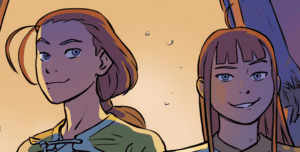
The Gaang, meanwhile, head to the beach, which Aang had decided to clean up, much to the others’ dismay. But as he says, he wants to feel like he’s doing something, even if it’s just cleaning up a part of a beach – which is absolutely littered with scrap and garbage. As they perform this less than glamorous task, Aang is approached by two kids who are in awe of him. Even more so after they reveal they’re firebenders and Aang in turn tells them he knows Firelord Zuko. Sokka wonders if they’d be as impressed with Aang if they were non-benders. Although he passes it off as a joke, as is his wont.
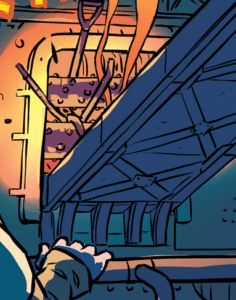 Later that night, Toph wakes up to a suspicious noise. As it turns out, someone had jammed the ore-processing machine, which causes it to explode. Toph and Aang takes off in pursuit of the saboteurs as Katara remains behind to put the fire out. The saboteurs turn out to be… the firebenders we’d seen the two young women recruit. Toph fights a young woman while Aang chases the old leader of the gang. He corners him on a cliff overlooking the water and quickly overcomes his valiant but futile resistance… before the cliff crumbles, sending him plummeting to his doom.
Later that night, Toph wakes up to a suspicious noise. As it turns out, someone had jammed the ore-processing machine, which causes it to explode. Toph and Aang takes off in pursuit of the saboteurs as Katara remains behind to put the fire out. The saboteurs turn out to be… the firebenders we’d seen the two young women recruit. Toph fights a young woman while Aang chases the old leader of the gang. He corners him on a cliff overlooking the water and quickly overcomes his valiant but futile resistance… before the cliff crumbles, sending him plummeting to his doom.
Which wasn’t a coincidence, as we see the two women who had hired the firebenders observing the spectacle. The earthbender caused the cliff to crumble to silence him… but unfortunately for them, Aang is there to swoop to his rescue. The two (whose names are Ru and Yaling) report back to Liling, who unsurprisingly turns out to be their mother. They argue and try to blame each other, but Liling cuts the argument short, insisting that while it’s unfortunate that their patsy had survived, it’s too late to do anything. She insists that they must stand together as family and that not even the Avatar can stop their plans. Thus setting her up as the most likely villain of Imbalance.
That’s enough for a recap. What are my impressions of the story and characters?
The bender/non-bender conflict
To start with, people actually talk about the conflict more than one sentence at a time and we see it rather than just being vaguely told about it. That’s already a major upgrade from the franchise’s previous attempts. But that’s a low bar to clear, so let’s dig into what we get.
Unsurprisingly, the root of the conflict seems to be in quickly-changing technology and social conditions. Cranefish Town grew quickly and is full of people who came seeking work but there’s just not enough of it for everyone. This bred poverty and inequality, with all that it implies. Benders are of course privileged in the pursuit of work… or were, until recently.
As I mentioned in the recap, we actually see benders end up on the wrong side of the changing world. Advanced machinery reduces the need for bending in ore processing, making highly-skilled benders less economical. After the first round of layoffs, the other benders felt machines were replacing them.
With no work, benders ended up criminals. This adds some appreciated nuance to the situation, for now at least. We’ll see how it progresses from here. Still, it’s hard to forget that the benders’ perspective is that of a privilege they lost. One that non-benders never had.
After all, if non-benders got to keep their jobs in the ore-processing plants, it’s because they demanded lower wages. And there’s more of them, so the positions operating the machines can’t provide work for all of them. Satoru’s goals here are, after all, to reduce overhead and keep the factory running more smoothly and economically. This makes both benders and non-benders victims of capitalism and the demand for profit.
Even those non-benders who do have jobs are afraid to leave their homes to work at them, due to bending gangs in the streets. Which is the more down-to-earth sort of inequality, less tied up with economic forces. Benders are simply more dangerous if they turn to violence. We see it rather clearly during the first fight that the Gaang witness.
The non-benders’ refusal to let Aang and Toph repair the damage was a curious story element to me, one that I liked. It might seem irrational, but I think it makes sense considering the circumstances. Their home was destroyed by benders – if they let benders repair it, their livelihood depends even more on the whims of benders. They’d rather keep their pride and regain their home with their own hands. One of them even sneeringly asks Aang if he’s going to force them to accept his help. It suggests that they view benders largely as people who go around and bully others with their power. And Aang is just the biggest bender of all.
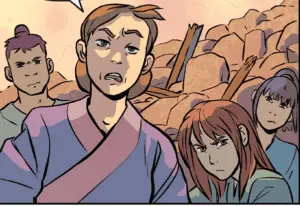
Unlike in the first season of Legend of Korra, the council running the city is split between benders and non-benders. Which is both better and worse than when it had one member for each nation, but no non-benders for some reason. Lao’s proposal of banning bending on the streets is controversial, but one can see where he comes from. Still, benders are not going to be happy about a suggestion to forbid them from using their natural abilities. It does treat them as dangerous until proven otherwise, in a way.
It’s hard to deny that whenever action starts, non-benders aren’t part of it. The guards of the metalworks are non-benders, but they don’t do anything except raise their shields between Lao and incoming rocks. Ru might or might not be a bender – either way, she just stands around while her sister mops the floor with a whole room full of firebenders.
No one except Lao seems to take the idea of non-bending police officers terribly seriously. And we do know that the only non-bending officer we saw in the first season of Korra was issuing tickets for vagrancy. Then there were the two detectives whose obstruction of Mako’s investigation made some think they were corrupt, but they were actually just that stupid. But that was in Book Two, which entirely forgot any bender/non-bender tensions.
I bring it up because this comic does seem to take on some topics that Book One of The Legend of Korra ignored entirely despite how obvious they were to the bender/non-bender conflict. The problem of bender-dominated law enforcement is one such thing. But can it really deal with those problems, if it has to eventually result in the status quo we saw in 2012? One that led to the Equalist revolution?
That’s for the central conflict of the story. Now let’s take a look at how individual characters acquit themselves in the first part of Imbalance.
The dramatis personae
Aang
The Avatar is his usual self here. He wants to help everyone and feels like the whole world is on his shoulders. But he also finds the pace of progress off-putting and feels like the world is leaving him behind. Once again he has to accept that progress is inevitable and simply try to guide it down the right path.
Katara
Katara’s portrayal in the Avatar franchise after the ATLA finale hasn’t exactly been stellar. I can’t help but feel like this comic doesn’t help. She spends her time hanging off Aang’s arm, providing him with moral support and performing off-screen tasks like saving civilians and putting out fires. Obviously, space on a page is in limited supply and the authors have to dole it out. But it’s hard not to see it as part of Katara’s consistent sidelining.
Toph
Toph promises to potentially play a more crucial role in the story, which we’ve only seen hints of so far. She’s now an executive partner in Earthen Fire Industries and seems to take her job quite seriously. Which means that it ruffles her feathers when her father is much more concerned with getting Aang’s help with the city’s problems. She also cavalierly dismisses the challenges of benders who had lost their jobs, because she feels like her metalbending is irreplaceable. It won’t surprise me if all of those come to a head. And, after all, we know that when Republic city eventually got a metalbending police force, she was its leader.
Sokka
Sokka’s part in the story has been relatively minor so far, and I hope it changes. As the Gaang’s token non-bender he is, after all, right square in the middle of the conflict. So far he proved content to sit out a fight between benders but offered his insight into the problem later. He also wonders if the two kids at the beach would idolize Aang so much if they were non-benders.
Lao Beifong
Toph’s father plays a pretty major part in the first book and is an ambiguous figure. His treatment of Toph is rather cold and callous, but maybe we can excuse it somewhat due to the town’s problems. He does seem genuine in trying to fix them, but also rather eager to hide behind Aang in doing so. His proposal to ban bending in the streets is drastic, but meant to combat a real issue… and yet he also tries to push it off onto Aang.
Satoru
I don’t know much about Satoru, having not read The Rift. In this comic, his actions in running his factory drive much of the conflict. His pursuit of efficiency and innovation ended up putting benders out of work and creating a rift between them and non-benders. He seems regretful of it, as his only goal was to make his factory work better.
Liling
And here is the villain of Imbalance as established by having the last panel of the book focus on her face as she gloats nefariously. While we never saw her bend, she sat on the benders’ side of the council. She offered the services of her security team to serve as law and order in Cranefish Town. Later on, we see her two daughters, one of whom is an earthbender, bully firebending criminals into sabotaging Earthen Fire Industries.
Her motives for it all are a mystery as of yet. The only hint we get is when she speaks to her daughters, claiming that she had asked them to do what they did for their family and the future of their home. Maybe she intends to sabotage the technology and progress that threaten the benders’ place in the world.
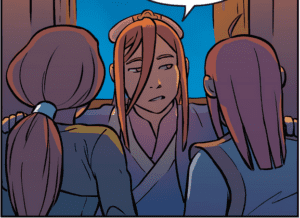
However, one of her daughters, Ru, is rather conspicuously not bending. She does the talking while Yaling beats people up and collapses cliffs. Is she a non-bender, then? If so, how does that fit into her mother’s plans? Maybe they’re not quite as bender-centric and simply use the tensions in the city for their own ends like Noatak used the Equalists as patsies for his personal revenge. That would be somewhat disappointing, but I won’t rule it out.
Still, it brings to attention something that I wonder if it’ll become relevant. The comic makes the bender/non-bender starker than any other part of the Avatar franchise, with both groups engaging in “us versus them” thinking. And yet, it’s not as simple, because families can have both benders and non-benders in them. Liling’s family might be one such example, but there’s also Toph’s family. How do they deal with this?
For now, Liling’s status as the instigator of the sabotage is out of our protagonists’ sights. Aang and Sokka only saw her as the calm, reasonable, and helpful councilwoman who offered a better solution than Lao had. She’s definitely shaping up as a manipulative and subtle villain, rather than an obvious threat. Of course, this can change.
Well, here we go. For now, I have reasons to be cautiously optimistic, as the new writer seems to know where she’s going with the story and its central conflict. The specter of having to eventually end in a way that results in LoK’s Book One looms over it, but maybe it won’t stop the story from being entertaining and more in-depth.

